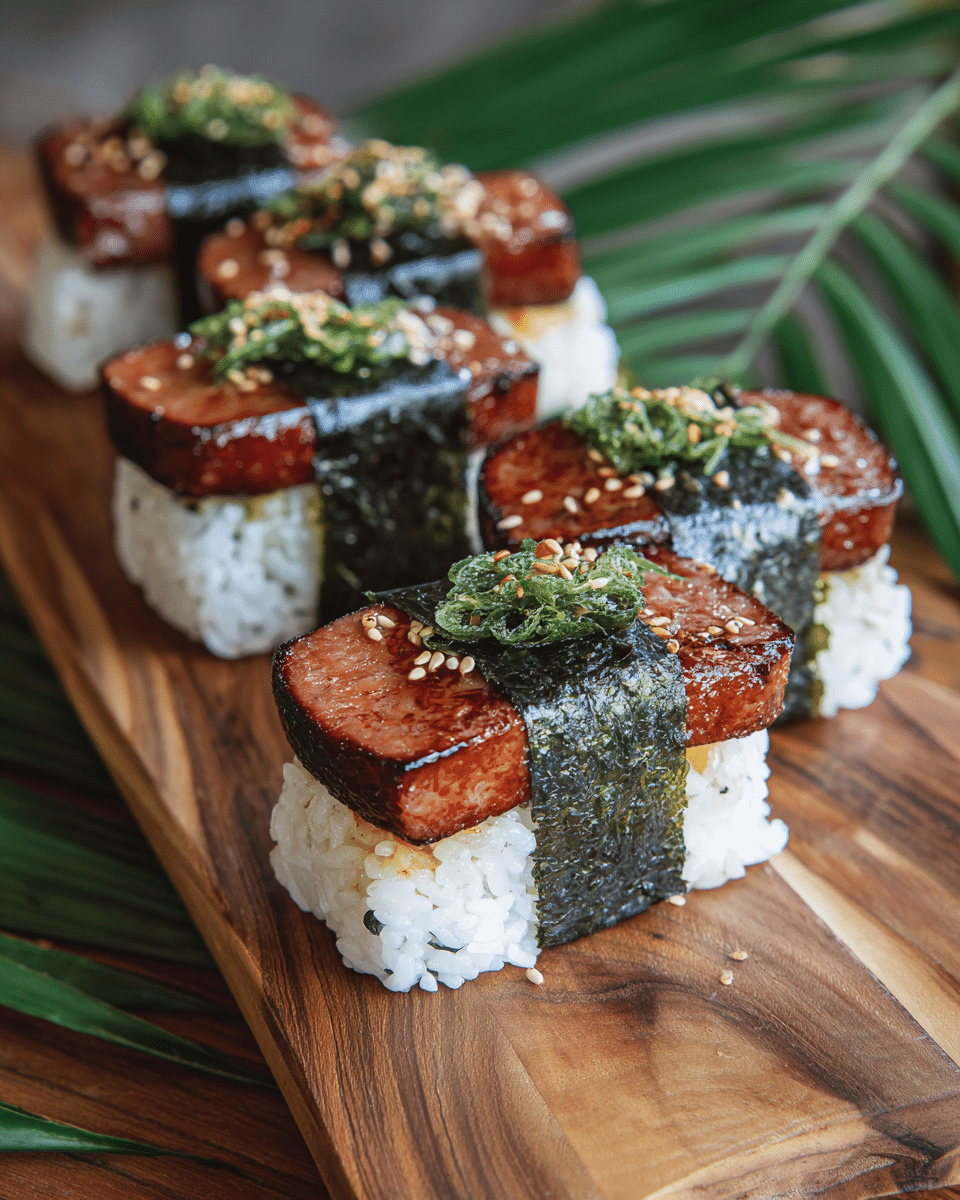Luncheon Meat Musubi is a beloved Hawaiian snack that brings together the comforting flavors of sweet and salty in a convenient handheld form. Often enjoyed at beach picnics or as a quick lunch, this dish features seared slices of luncheon meat (commonly SPAM) glazed in a sweet soy sauce mixture, placed on a block of rice, and wrapped with nori (seaweed).
FULL RECIPE
Ingredients
- 1 can (12 oz) luncheon meat (e.g., SPAM)
- 3 cups cooked short-grain white rice (warm, not hot)
- 2 tablespoons soy sauce
- 2 tablespoons sugar
- 1 tablespoon oyster sauce (optional, for depth of flavor)
- 1 teaspoon sesame oil
- 1 tablespoon rice vinegar
- 1/2 teaspoon salt
- 4 sheets of roasted nori (seaweed), cut into thirds
- Cooking oil or spray (for frying)
- Optional toppings: Furikake seasoning, scrambled egg, avocado slices
Directions
- Prepare the Rice: While the rice is still warm, mix in the rice vinegar and salt. Stir gently to avoid breaking the grains. Set aside to cool slightly.
- Slice the Luncheon Meat: Remove the meat from the can and slice it into 8–10 even pieces.
- Fry the Slices: Heat a skillet over medium heat and lightly coat with oil. Fry the luncheon meat slices for 2–3 minutes per side, or until golden and crispy.
- Make the Glaze: In a small bowl, mix the soy sauce, sugar, oyster sauce (if using), and sesame oil. Pour the mixture into the skillet with the fried slices and cook for 1–2 minutes, flipping the slices to coat evenly until the glaze thickens slightly.
- Shape the Rice: Wet your hands or use a musubi mold. Form the rice into compact rectangular blocks roughly the same size as the meat slices. If using a mold, press about 1/2 cup of rice into it firmly, then remove.
- Assemble the Musubi: Place one slice of glazed luncheon meat on each rice block. Wrap a strip of nori around the center, seam side down, to secure the layers together. The seaweed will naturally stick as it absorbs moisture from the rice.
- Optional Additions: You can sprinkle furikake seasoning over the rice before adding the meat or layer extras like thin scrambled egg or avocado slices between the rice and meat for added flavor and texture.
- Serve or Store: Serve immediately, or wrap tightly in plastic wrap and refrigerate for up to 2 days. Best enjoyed at room temperature or slightly warmed.
Nutrition Facts
- Calories: 275
- Total Fat: 14g
- Saturated Fat: 5g
- Cholesterol: 35mg
- Sodium: 720mg
- Total Carbohydrates: 28g
- Dietary Fiber: 1g
- Sugars: 5g
- Protein: 9g
- Iron: 1.2mg
- Calcium: 15mg
- Potassium: 140mg
Cultural Significance of Luncheon Meat Musubi
Luncheon Meat Musubi holds a special place in Hawaiian cuisine, blending Asian influences with local traditions. After World War II, canned luncheon meat like SPAM became widely available and integrated into the diets of many Pacific Islanders. Musubi emerged as a way to combine this shelf-stable protein with traditional Japanese rice and nori, creating a fusion food that reflected Hawaii’s multicultural identity. Over time, this snack became a staple in lunch boxes, convenience stores, and family gatherings across the islands. Its evolution from a war-time necessity to a beloved delicacy showcases the creativity and resilience of Hawaiian food culture.
The Perfect Balance of Flavors
What makes Luncheon Meat Musubi stand out is its harmonious blend of sweet, salty, and umami-rich flavors. The fried luncheon meat, often glazed with a mixture of soy sauce and sugar, offers a caramelized, savory bite that contrasts beautifully with the mild, slightly vinegared rice. The nori strip adds a subtle hint of the ocean and provides texture, making each bite complex and satisfying. This perfect balance allows it to appeal to both kids and adults, and even those who don’t normally enjoy processed meats often find this dish surprisingly delicious.
Nutritional Overview
While Luncheon Meat Musubi isn’t considered a low-calorie or diet food, it can be enjoyed as part of a balanced diet. Each musubi provides a good source of carbohydrates for energy, protein for muscle maintenance, and fats for satiety. The luncheon meat contributes sodium and saturated fats, so moderation is key. However, the dish can be customized to include healthier components like brown rice, low-sodium luncheon meat, or added vegetables. In reasonable portions, it serves as a quick and convenient source of fuel, especially for active individuals or those looking for portable meal options.
Popular Variations
Many regional and personal variations of Luncheon Meat Musubi have emerged over the years. Some people enjoy adding scrambled eggs, avocado, or pickled vegetables for an extra layer of flavor and nutrition. Others replace the traditional white rice with brown rice, quinoa, or even cauliflower rice to meet dietary preferences. Another popular twist involves deep-frying the entire musubi in a tempura batter for a crispy exterior. Whether spiced with sriracha mayo or sprinkled with furikake, the dish remains versatile, allowing endless customization based on personal taste or dietary needs.
Tips for Rice Preparation
The rice is a crucial component of musubi, and its texture greatly affects the final product. Short-grain or sushi rice is ideal because of its sticky nature, which helps the musubi hold its shape. It’s important to rinse the rice thoroughly before cooking to remove excess starch, which ensures fluffier grains. Once cooked, the rice should be seasoned lightly with rice vinegar and salt to enhance flavor without overpowering the meat. Letting the rice cool slightly before assembly helps it firm up, making it easier to mold into shape.
Tools to Make Assembly Easier
While musubi can be shaped by hand, many prefer using a musubi mold to create uniform, tightly packed rice blocks. These molds are inexpensive and readily available, and they ensure each musubi is the same size, which helps with even stacking, presentation, and portion control. If you don’t have a mold, a clean SPAM can with both ends removed can be repurposed for shaping. Additionally, using plastic wrap or damp hands prevents the rice from sticking to your fingers during assembly.
Ideal Side Dishes and Pairings
Luncheon Meat Musubi pairs wonderfully with a variety of Hawaiian and Asian-inspired side dishes. It complements cold soba noodles, fresh fruit like pineapple or mango, or light salads such as cucumber sunomono. For a heartier meal, it can be served alongside miso soup, kimchi, or poke bowls. Its savory-sweet profile also works well with beverages like iced green tea or tropical juices. For gatherings, pairing musubi with other handheld treats like spring rolls or gyoza can round out a vibrant and well-balanced spread.
Storage and Make-Ahead Advice
Luncheon Meat Musubi is excellent for meal prep and can be made a day or two in advance. Once assembled, wrap each musubi tightly in plastic wrap to retain moisture and prevent the nori from becoming overly soft. Store them in the refrigerator, and allow them to come to room temperature before eating for the best texture and flavor. Avoid microwaving them too long as it may dry out the rice. If you prefer a crispy seaweed wrap, store the rice and meat separately, and assemble just before serving.
Healthier Ingredient Alternatives
For a lighter version of musubi, consider using low-sodium or turkey-based luncheon meat, which contains less fat and salt. Replacing white rice with brown rice or a mix of grains like barley or wild rice can boost fiber content. Adding vegetables such as sautéed spinach, shredded carrots, or pickled radish increases nutrient density and freshness. Even the glaze can be made healthier by reducing sugar or substituting it with honey or coconut aminos. These changes allow the dish to remain enjoyable while better supporting nutritional goals.
Why Musubi Is Perfect for On-the-Go Meals
One of the best aspects of Luncheon Meat Musubi is its portability. Individually wrapped and compact, it fits easily in lunch boxes, backpacks, or picnic baskets. It requires no utensils, making it ideal for road trips, beach outings, or quick lunches between meetings. Its shelf-stable ingredients (if unrefrigerated for short periods) mean it can be taken on hikes or long commutes with minimal fuss. This makes musubi a popular choice among students, office workers, and outdoor enthusiasts alike.
Conclusion
Luncheon Meat Musubi is more than just a tasty snack—it’s a cultural icon that reflects the fusion of Hawaiian and Asian culinary influences. With its simple preparation, customizable ingredients, and universally loved flavor profile, it continues to captivate food lovers across generations. Whether enjoyed fresh off the skillet, packed for a picnic, or jazzed up with creative toppings, musubi delivers satisfaction in every bite.






